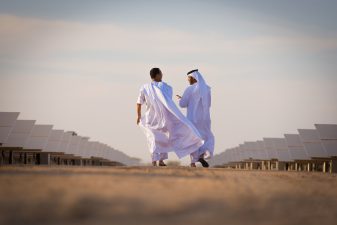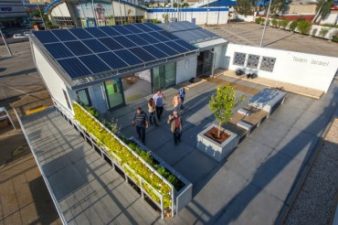The world’s largest wind farm in the outer Thames estuary has the capacity to deliver power to 500,000 homes and offset 925,000 tonnes of carbon dioxide emissions from the atmosphere. NASA reveals photos of the London Array taken from space – seen after the jump.
A joint development of which Masdar holds a 20 per cent share, the London Array occupies a total area of 39 square miles roughly 12 miles off the coast of Kent and Essex in the UK.
(People often asks me “what’s Masdar doing, is it the real deal or is it a farce? When they do, I point to projects like this to demonstrate the scope of the Abu Dhabi government-funded initiative.)
Phase one of the project includes 175 offshore wind turbines and two offshore substations, which can generate up to 630MW of clean wind energy.
London Array is currently seeking approval to allow the project’s second phase to proceed. If approved, Phase Two would be capable of generating up to 240MW, giving a combined generating capacity of 870MW.
Those numbers may seem impressive, but it’s not easy to put them into perspective. Which is why NASA’s photographs are always so helpful.

NASA has revealed how underground fresh water is vanishing from the Middle East, how drastically urbanization is changing the MENA landscape, and how pollution and seasonal weather conditions affect air quality across the region.
And now the organization reveals what the largest and best known wind farm in the world looks like from space.
From NASA’s Earth Observatory:
The wind farm became fully operational on April 8, 2013. Twenty days later, the Operational Land Imager (OLI) on the Landsat 8 satellite captured this image of the area. The second image is a closeup of the area marked by the white box in the top image. White points in the second image are the wind turbines; a few boat wakes are also visible. The sea is discolored by light tan sediment—spring runoff washed out by the Thames.
While the project has positive implications – since it generates a significant quantity of clean energy and reduces carbon emissions, critics warn that the wind turbines have a negative impact on marine creatures.
In particular, the Outer Thames estuary is important to red-throated divers, which are said to aggregate in large groups during non-breeding seasons.

Marine mammals, fish, and sea turtles are also said to suffer from noise, vibration, shadowing as well as current changes and electromagnetic radiation emissions.
NASA Earth Observatory image by Jesse Allen and Robert Simmon, using Landsat data from the U.S. Geological Survey. Caption by Michael Carlowicz.






This might be a good location for wave and ocean current generated electricity as well.
Overpopulation pushes human technology out into the sea. So, reduce the number of people with family planning programs Worldwide, while safely recycling !00% of all human-generated waste materials. Then the Earth will return to its natural balance.